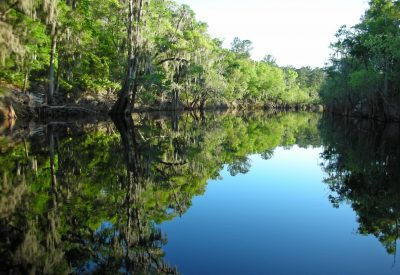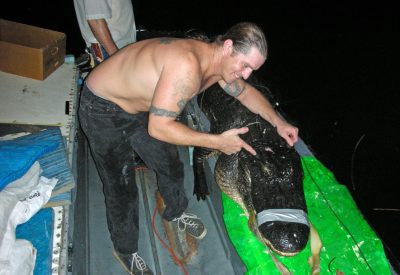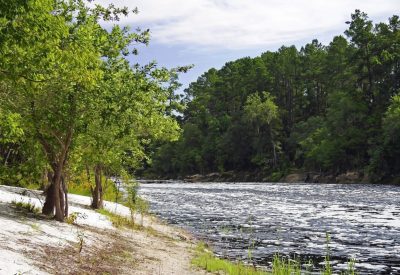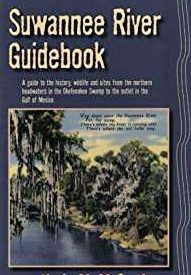Florida Waterways
“Big Shoals State Park”
By Kevin McCarthy
Captions:
Most of the Suwannee is peaceful and calm.
My son with a gator we caught in the Suwannee
Big Shoals State Park
Another view of the rapids
The rapids
The cover of my guidebook
When we think of Florida rivers, we usually think of calm, gently flowing waterways on their way to the ocean or Gulf. We don’t think of rapids, and yet the Suwannee River has a series of rapids that can surprise and even injure the unsuspecting boater. The rapids are part of Big Shoals State Park, which is about a mile east of White Springs in Hamilton County. The rapids, the biggest in Florida, can offer a formidable challenge to the unsuspecting boater.
I first discovered the rapids when I was boating with a friend, Cary Crutchfield (the co-publisher of this fishing/boating magazine) 12 years ago. About an hour after we launched the boat into the river, we heard a rumbling sound from several miles ahead and knew that we were approaching the rapids. The danger of the rapids depends on how deep the river is when boaters are heading west. If the river is high from heavy rains or a big storm, boaters can glide over the rapids and barely be aware of what lurks beneath the surface. If the river is low, during drought or at certain times of the year, the sharp rocks cannot be crossed by most boats. Boaters should not attempt the rapids in the evening or in the dark because of the difficulties they can encounter.
The Big Shoals are part of a conservation area consisting of 3,400 acres, a relatively wild stretch that has three miles of river frontage and more than thirty miles of multi-use trails, that follow the river, and wind among some very pristine parts of the state.
The impassable nature of the rapids/white shoals has to be one reason why nineteenth-century steamboats did not open up the Suwannee River and Valley to settlers the way that the unobstructed St. Johns River on the east coast of the state opened up Central Florida to thousands of settlers. Those settlers on the east coast included many invalids who were escaping the cold of the North, for the warmth of the Sunshine State. As their health improved and their families grew, settlements grew up along the St. Johns, something that did not happen along the Suwannee, and thus even today the latter river is relatively unsettled compared to the St. Johns.
During this pandemic, that state park and others have restricted hours and facilities, including restrooms. Prospective visitors should check out the latest information about the state park on the website of the state park system.
Kevin McCarthy, the author of Suwannee River Guidebook (2009 – available at amazon.com), can be reached at ceyhankevin@gmail.com.






